Shihaam’s fondest abalone memory dates to her childhood. “My first one was during Carnival in February, where we knew the treat you were going to have would be abalone burgers. They were bigger than my face,” she says.
Growing up, she long felt a deep connection to the land and the sea.
“In my adult life, I went diving for abalone and realized how empty the ocean beds are, and how the rocks are stained where the abalone used to live and how the kelp are taking over,” Shihaam says.
As a highly involved community activist living in the Cape Flats, she is well versed in the intricacies of how illicit abalone poaching has primarily affected indigenous communities of color along the South African coast, between Cape Town and Gaansbaai. In almost every town we visit together, she instantly connects me to people living in these local fishing communities, something that would generally be impossible as an outsider.
Our first stop is at the edge of Kleinmond town, where we veer onto a dirt road heading toward the coastline. There, she gestures at numerous large, discarded perlemoen (Afrikaans for abalone) shells strewn amidst the bushes. “The poachers have pillaged the entire shoreline from Betty’s Bay to Hawston. These are people living day to day. The original inhabitants of the town are the people who are suffering the most,” she says.
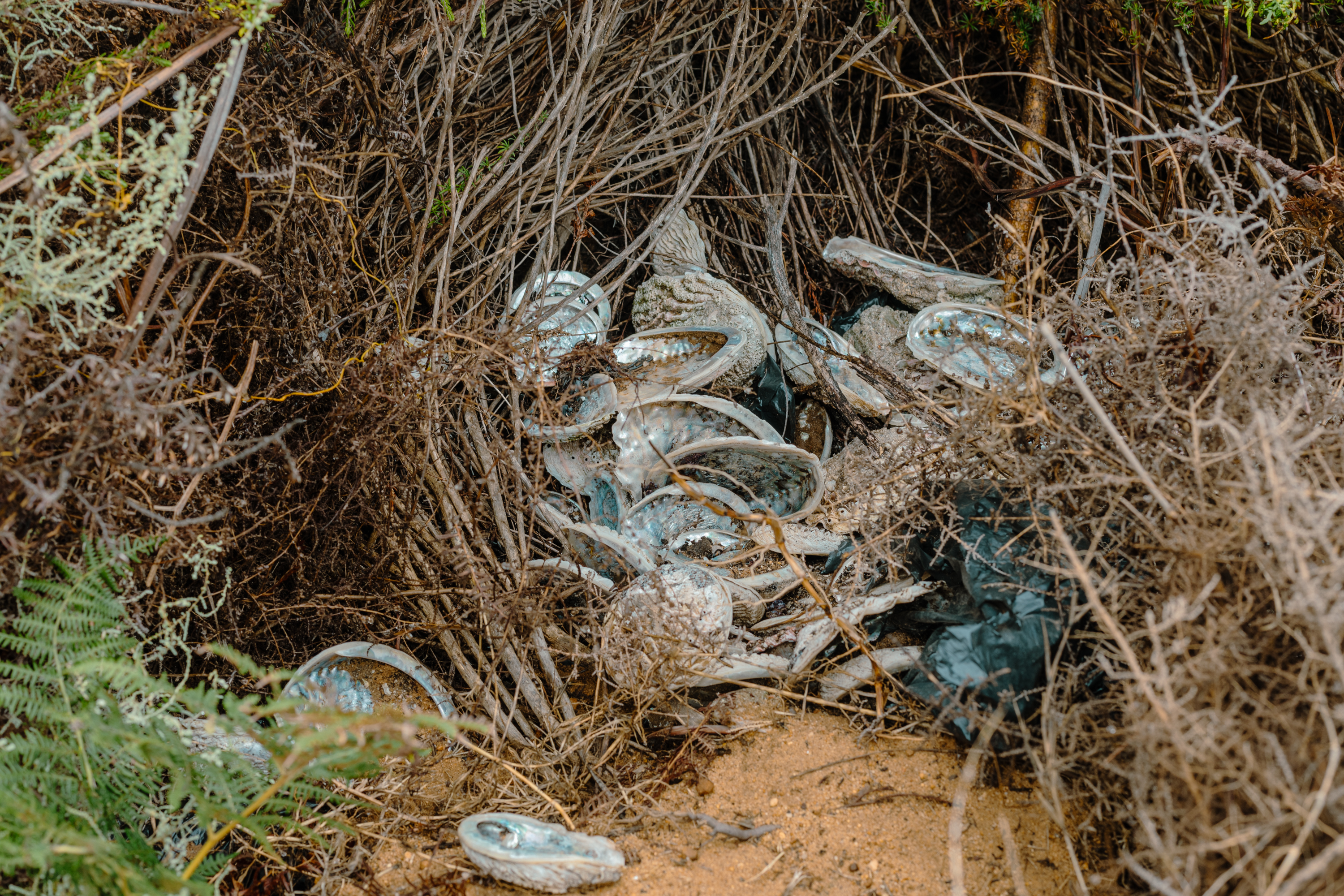
Discarded shells found along the side of the road near the coast in Kleinmond. The abalone meat is shucked out of the shells after divers exit the water and stored in freezers in the town or given to middlemen to dry them in “cookhouses.” Photo by Nicholas Muller.
Papi
Papi, 60, started fishing and diving young. For more than a century, his family lived in a big house on the harbor. His generation grew up with abalone. During that time you could pull it off the rocks.
“There were canning factories for abalone there going to China and the Whites were doing that business. During the Apartheid years, they kicked us out with my parents and 11 children, and took us away from it, and we moved into a one bedroom space,” he says.
Decades later, “The government came and said that they were closing it for a period, but then they didn’t open it again and now it’s been over 20 years. This community is not allowed to have abalone anymore,” Papi says.
“What must we do now to make a living? It could sustain the whole community and people’s health is compromised too because their diet has changed,” he says.
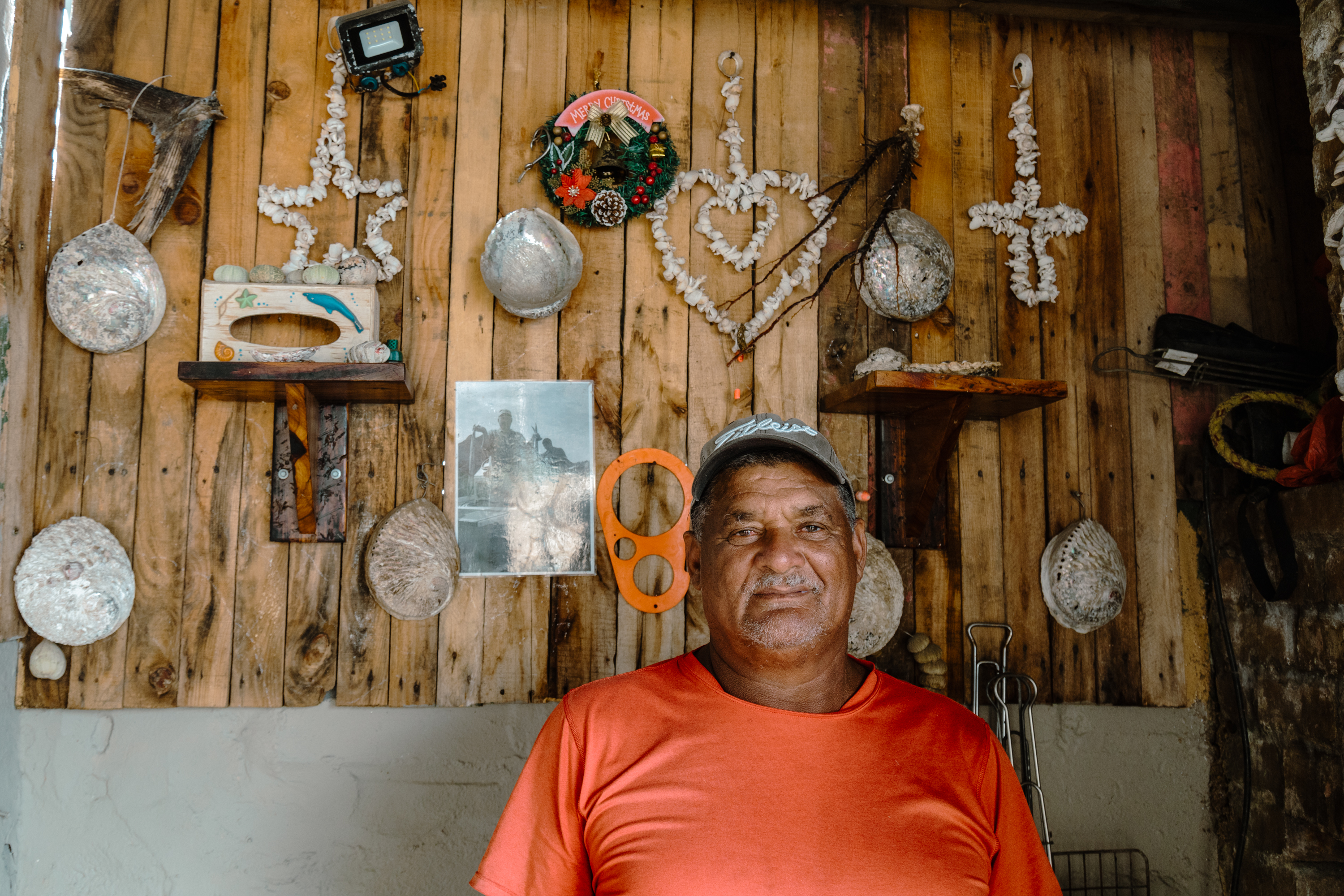
Papi, 60, a lifelong fisherman in the coastal community of Kleinmond, is from one of the oldest families. His family used to live in a big house in the harbor for more than a century before being forcibly relocated away from the sea. Behind him, large abalone shells, or “Perlemoen” in Afrikaans, hang on his wall. Photo by Nicholas Muller.
“They cut people off from their food source completely,” says Shihaam.
Then the poaching started.
“There was a lot of abalone here before; they called it ‘poachers paradise.’ Now abalone is nearly extinct here, there’s nothing in the water because of poaching. Twenty men stand around the water and say there’s nothing,” he says. “Now you must go deep to find it with scuba gear.”
“We had to reapply for a permit to get abalone, and the people who were born here didn’t get permits. But the Chinese factory in Kleinmond does have one,” he says.
It was not clear during reporting if the factory operating was actually Chinese.
“How do you live on 20,000 rand [1,000 euros] for a whole year on the current fish quotas?” Papi asks, citing the legal fish quota, which does not include abalone. He blames buyers and poachers, and lack of government intervention for the situation. The going rate for illicit abalone has skyrocketed from 60-80 rand [$4] to 1,200 [$60], and Papi is incredulous that it’s sold for 1,000 [$54] rand per portion in Hong Kong. He wonders whether abalone has brought more harm than good to Kleinmond.
“Unbelievable! I think maybe this abalone was a curse for us!” Papi says.
“Hong Kong and China don’t care what they’re doing to us here. They are crippling communities and are wiping out entire families. My grandchildren don’t even see abalone or have even heard of it, and neither will my future generations,” he ends.
Russie
20 minutes from Kleinmond is Hawston. Russie, a longtime diver, says it was one of the spots where abalone poaching started in South Africa.
“From a young age, we saw people go to the sea, and you learn to follow in their footsteps. We have a deep history concerning diving for abalone. We don’t have blood in our veins, we have seawater. For 30 years, I’ve been getting up at 4 a.m., ” he says.
Russie says he used to have a quota, but did not want to get involved in the social ills of poaching which brought drugs and elevated gangsterism in Hawston. For not joining the poachers, he says he got kicked out of the system.
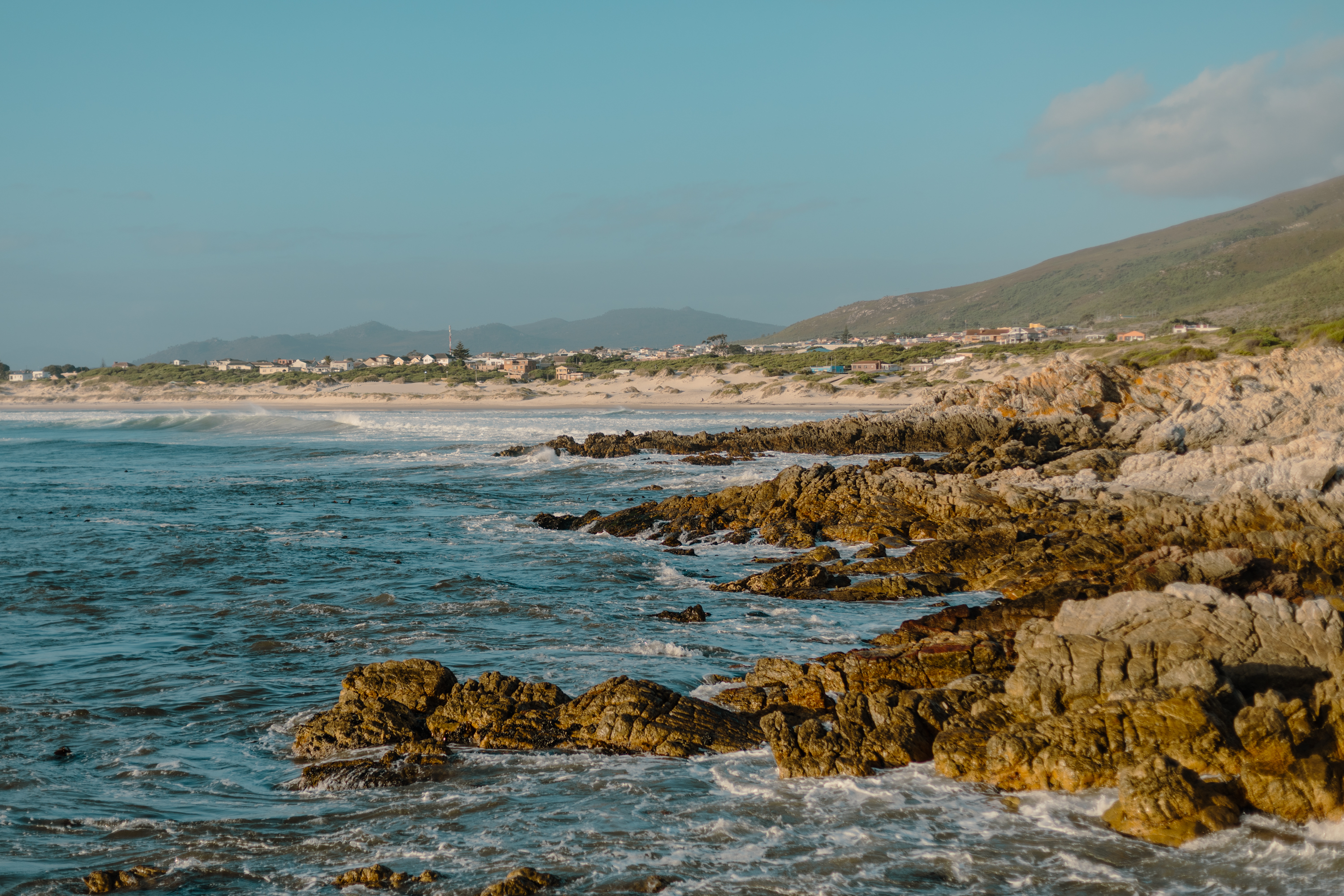
A view of Hawston, a community along the coast long known as one of areas for abalone poaching. Now abalone is scarce. Photo by Nicholas Muller.
“We could have learned another occupation to feed our families. But we are still getting the Apartheid treatment. Our quotas are not viable, they are too small, so people are poaching. Since we only work once, we must budget that paycheck for the whole year until the next season. There is no other work here,” says Russie.
“They started a poaching syndicate, which started a connection to China. Now the Chinese are bringing drugs and guns into the area, which further cripples the community, and are trading it for abalone. It completely destroys society. People are killing each other,” he says.
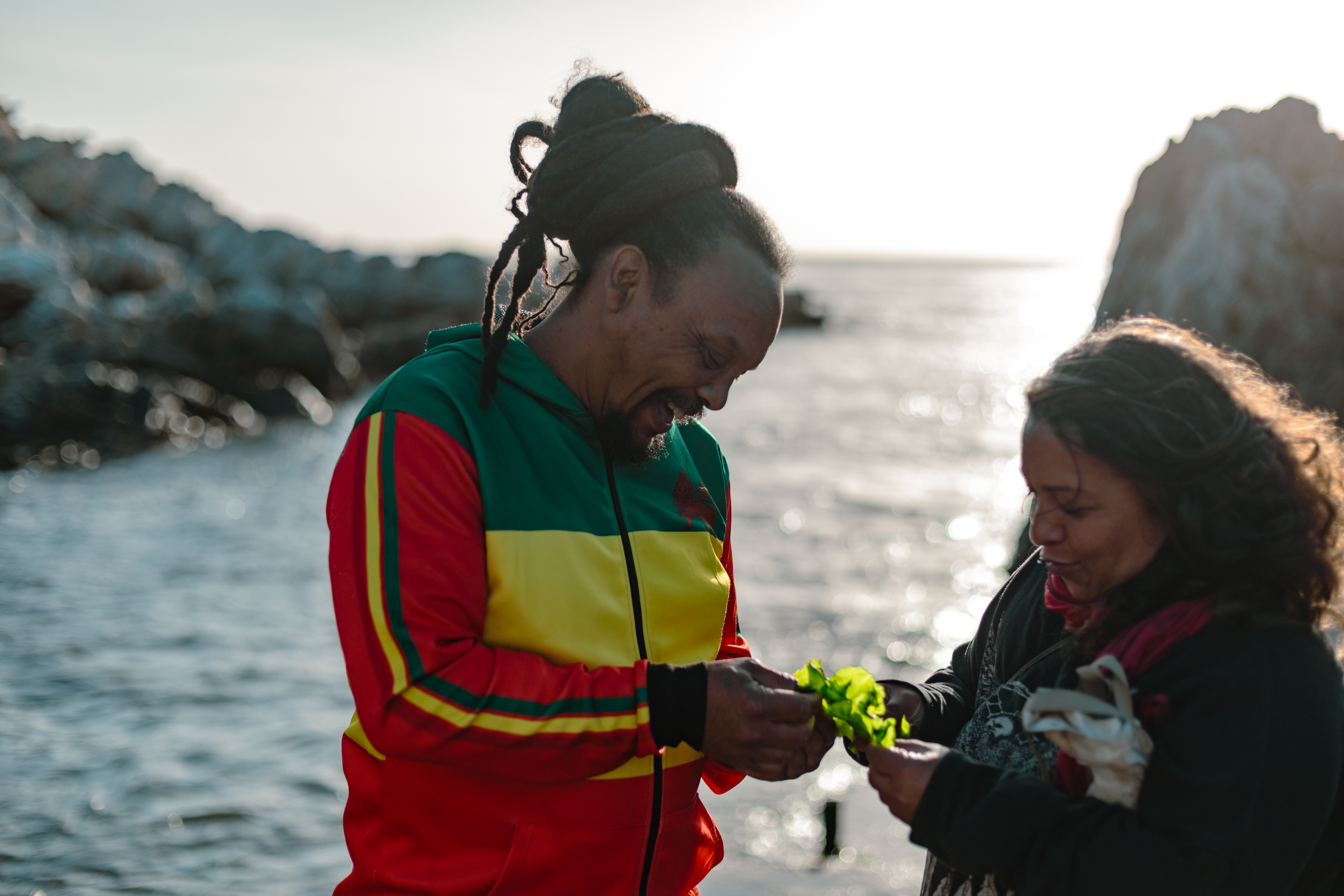
Russie, from Hawston, is a long-time diver and fisherman. He is seen with Shihaam. Photo by Nicholas Muller.
Russie says there are sometimes brutal and dramatic police raids, and some people have gotten long prison sentences for poaching and smuggling. Much has changed.
“Abalone has brought a criminal underworld here; there are syndicates operating this business. Normal people can’t work in this anymore. They have to join a syndicate. The government works together with the syndicates. People feel forced to give the abalone to the syndicates because it’s where the money is. They are bringing hard drugs in here like crystal meth and cocaine and exchanging it for abalone,” he ends.
He takes a bag of large abalones out of a freezer.
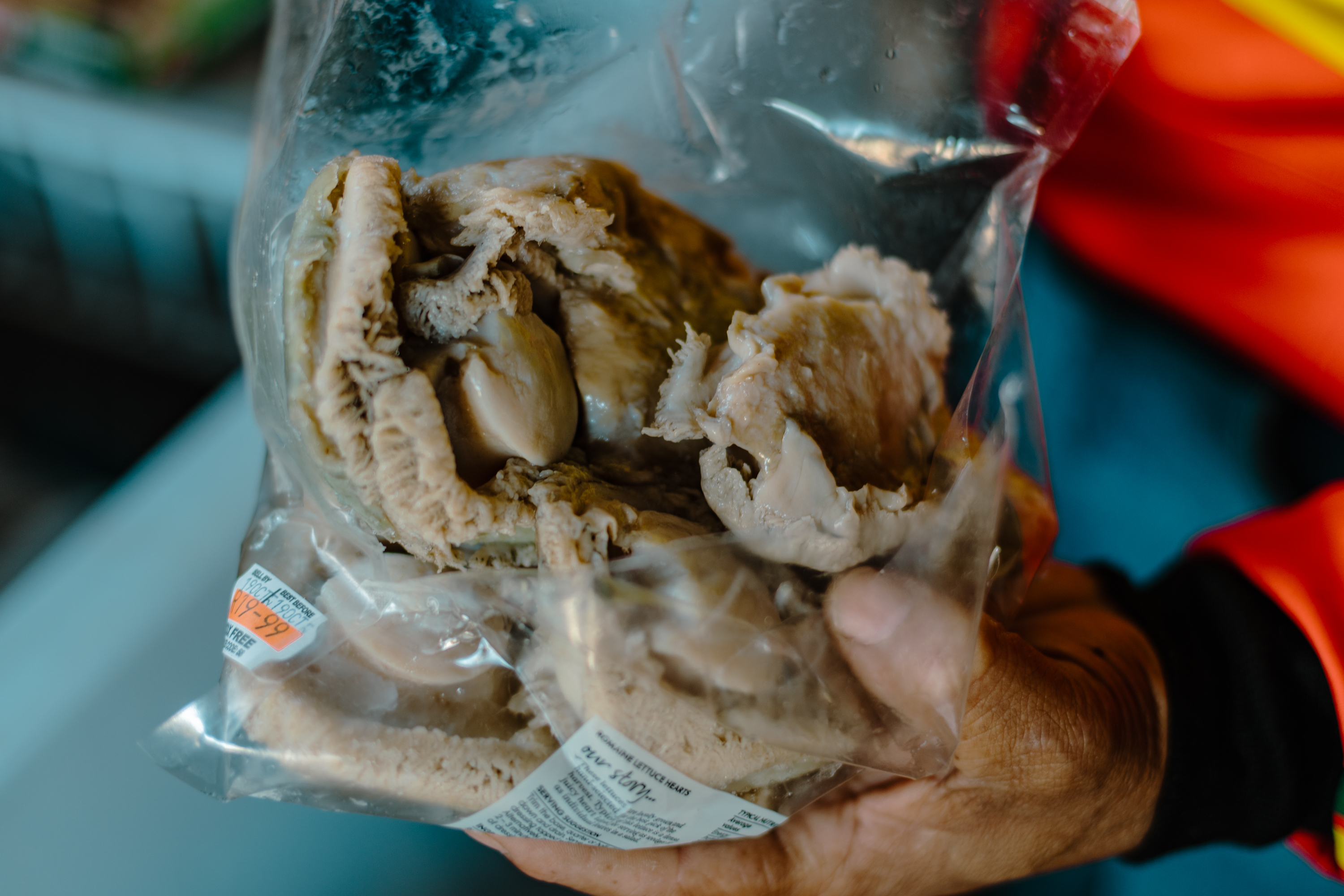
A bag of large recently shucked abalone at a diver’s house along the coast in the town of Hawston. Photo by Nicholas Muller.
A Diminishing Species
The International Union for Conservation of Nature reports that nearly half of all abalone species worldwide face extinction due to pollution, climate change, and broader marine wildlife devastation.
With the multitude of accessible and hidden spots along the extensive coastline, South African authorities find themselves unable to adequately patrol the area. It’s widely acknowledged that many in positions of authority turn a blind eye or are directly involved in the illicit abalone trade.
Kimon de Greef, a freelance journalist and researcher, has long studied the illicit abalone trade. He co-authored the book “Poacher: Confessions from the Abalone Underworld” with Shuhood Abader.
According to de Greef’s reporting, “corruption is rife and money has seeped into every single anti-poaching agency – the police, the South African revenue service, fisheries, national parks – and allowed it to grind on.” He continued: “20-25 percent of confiscated poaching, hundreds of tons per year, is sold at auctions by the fisheries department and exported to Hong Kong. This correlates with the suspicions of many in these communities that the government is complicit.”

A house in Hawston decorated with large abalone shells on its facade. Photo by Nicholas Muller.
Despite the growing scarcity and inherent risks involved in finding abalone, divers continue to scour the coastline due to intense demand from customers in Hong Kong and China. It is a lucrative $60-120 million per year illicit business, according to TRAFFIC Wildlife Trade Monitoring Network.
“No one really knows the percentage of abalone left [in South Africa] but it is in the single digits. The damage is done at an ecological level. The decline happened so quickly that we don’t know the environmental impact,” says de Greef.
“The rate at which poaching accelerated and the rate at which the abundance declined was so great there were no comprehensive studies undertaken to establish what the ecosystem role was and what the effect on removing so much abalone so quickly was,” he says.
Despite attempts to understand current data, WWF South Africa did not respond to a request for comment on this story.
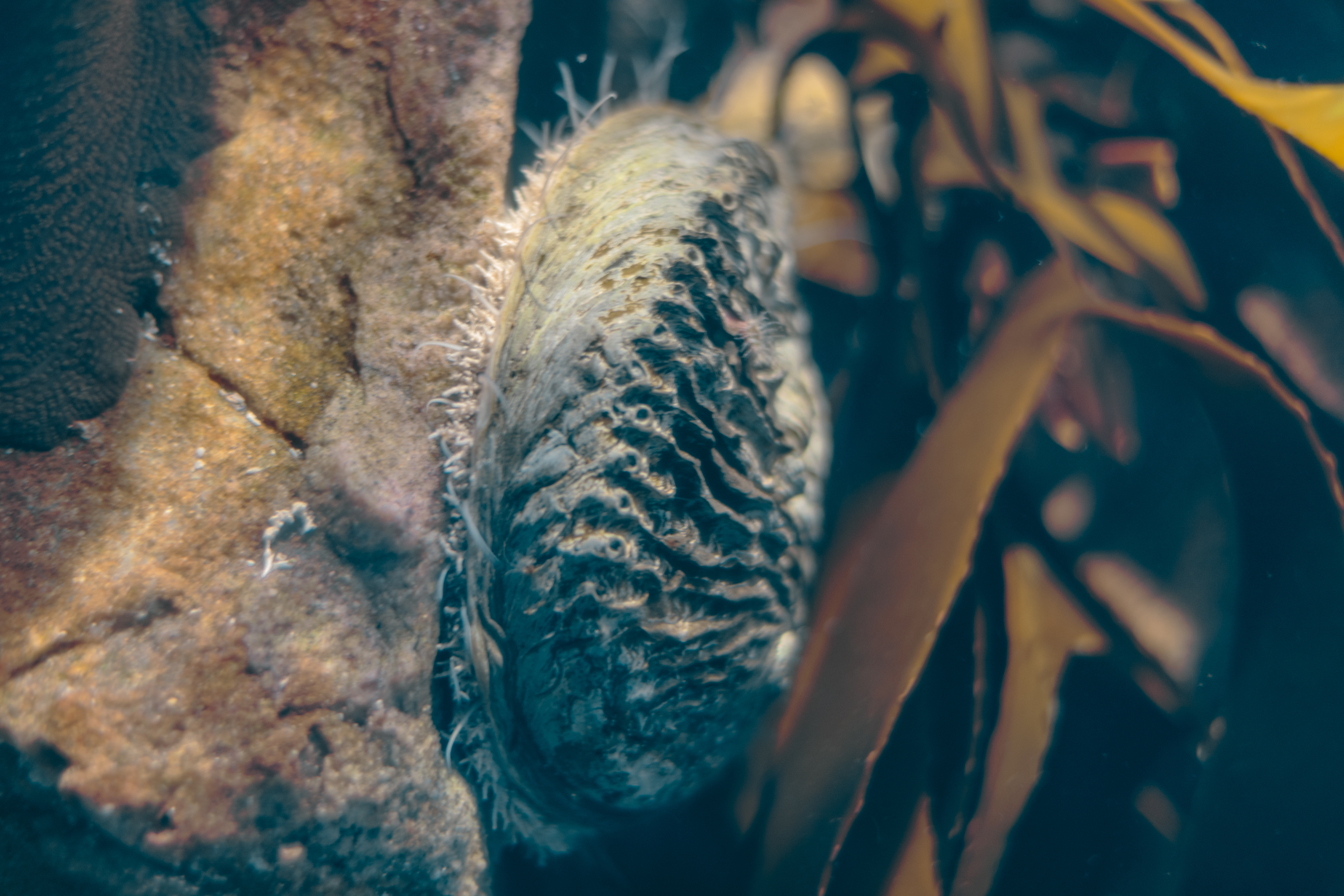
A live abalone at the Two Oceans aquarium in Cape Town. Photo by Nicholas Muller.
All the Way to Hong Kong
At its endpoint, Hong Kong stands as the epicenter of the abalone trade in Asia, as it has for decades been the crossroads for various kinds of globally trafficked wildlife. Local and mainland Chinese consumers are willing to spend hundreds of dollars per piece or kilogram on the prized seafood. Stores scattered around Sheung Wan district on Des Voeux Road West and Wing Lok Street of Hong Kong have the highest concentration of dried seafood merchants selling abalone in the city.
“Literally every store in those streets sells dried seafood, abalone, sea cucumber, etc,” says Celine, a long time Hong Kong resident. “Whole dried abalone are one of the four premium Cantonese dried seafood delicacies or ‘treasures’ along with shark fin, sea cucumber, and dried fish maw.” South African abalone is considered to be second in terms of its desirability to locals, after Japanese abalone.
“Normally, Hong Kong people consider abalone as a very fancy ingredient for a dinner, especially during Lunar Year, a wedding, banquet, or for some special occasion. So we will eat fresh abalone, steamed with some orange peels, or with garlic, or sometimes throw it into a hotpot,” says Vanessa from Hong Kong. During the Lunar New Year, increased demand for abalone leads to a surge in prices.
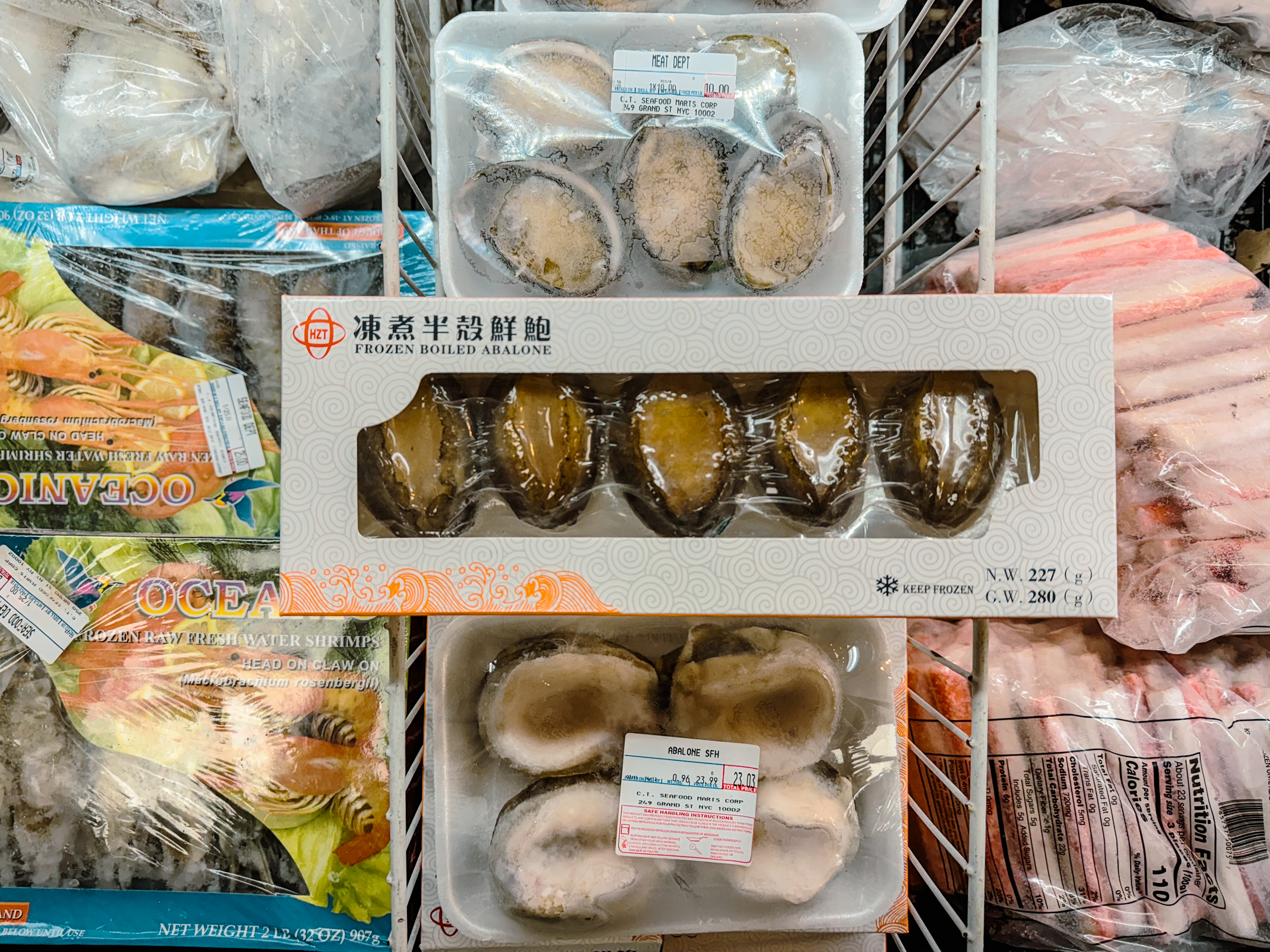
Various types of imported frozen abalone found in New York City’s Chinatown. It is unclear where they are sourced from. Photo by Nicholas Muller.
“People are willing to spend a lot of money because it is a fancy ingredient and they don’t mind spending more money to treat their friends and family,” Vanessa says.
Celine agrees. “It’s a status symbol and deeply ingrained in the culture here. It’s not about the taste. The taste comes from the pork, chicken, or fish it’s always cooked with. Abalone has no unique taste itself. Most children I know don’t like eating it either, because it’s really tough and chewy, but their parents love it. It’s the food equivalent of whipping out an iPhone or Louis Vuitton bag. It’s expensive and so you’re flaunting because people will know you’ve got cash by eating it,” she says.
I asked if she thought locals are aware of its source and impact in South Africa. “I don’t think people know, nor do I think they care,” Celine responds. “Hong Kong is a place where people have known [eating] shark fin [means] killing an endangered species for decades but yet they continue to eat it and berate Westerners for telling them not to eat it.”
Abalone is “culturally significant for the same reason that shark fin is significant: It’s expensive and local people have eaten it since as long as they can remember,” she says.
An Underworld of Illicit Activity
According to de Greef, “Chinese criminal syndicates effectively manage the trade between South African poachers and importers in Hong Kong, and control the flow and prices.” He noted that it would be difficult for Hong Kong traders to bypass these intermediaries.
A 2018 TRAFFIC report concluded that 80 percent of abalone traders are aware of illegal activities within the sector, with triad groups often involved in coordinating poaching and illegal exports.
Speaking to the South China Morning Post, Markus Burgener, a senior program officer with TRAFFIC said, “Police take abalone poaching seriously, conducting an estimated 350 to 400 seizures each year… In 2019 alone, police reported seizures exceeding US$1.6 million in value, but that remains a fraction of the total activity.”
The SCMP also reported that WWF Hong Kong provides a seafood guide featuring a “traffic light system” to help consumers make environmentally informed choices about which species are safe to consume and urges the Hong Kong government to enhance seafood labeling, providing consumers with more information about the origins of their food. According to Loby Hau Cheuk-yu, assistant manager of oceans sustainability at WWF Hong Kong, this advocacy is crucial for empowering consumers. It is unclear to what extent consumers understand the process, however.
No Slowing Down
Many South Africans involved in the abalone trade are oblivious as to its final destination, or the reasons behind the high demand. However, as wild stocks of abalone become increasingly scarce, the black market price continues to soar. Haliotis midae, an abalone species exclusive to South Africa, is prized for its substantial size. In the past three decades, more than 100 million of these specimens have been poached and illegally harvested in South Africa.
Poachers are increasingly targeting the remote Robben Island, the place of Nelson Mandela’s long imprisonment, due to its perceived richness in abalone.
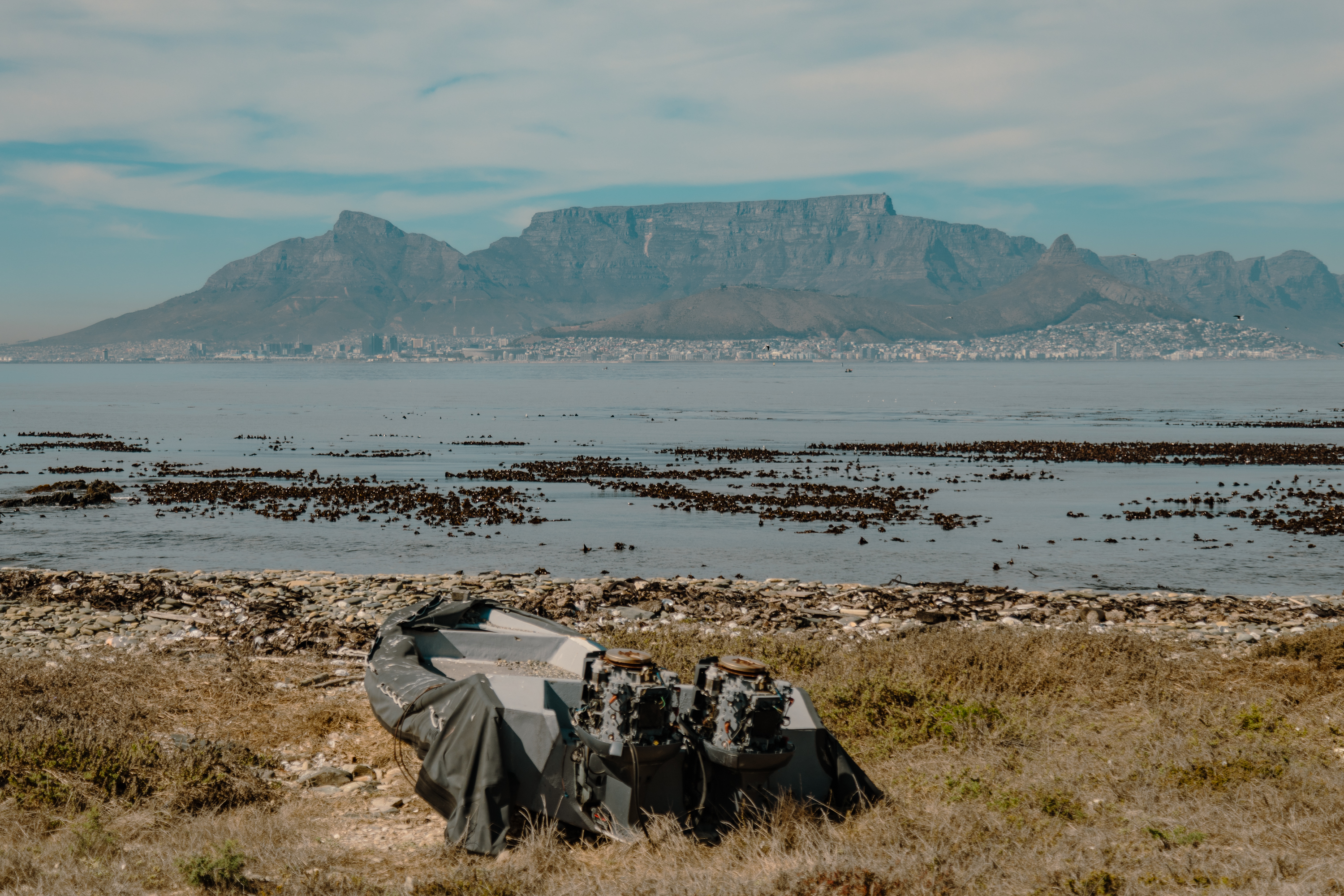
A “rubber duck” speedboat confiscated on Robben Island, famous for the imprisonment location of Nelson Mandela. The island is purportedly rich in abalone and has seen an increase in poaching from Hawston, Hout Bay, and further afield. Photo by Nicholas Muller.
According to a former political prisoner working on the island as a guide, “People are now terrified here and we have to lock our doors day and night. 20 poachers come here at once. It gets worse and worse. There is no protection from the government and the police are involved. It won’t stop. The coast is littered with shells. Many divers dive and ask for help after being caught on the island after making the treacherous journey from as far as Hawston and Hermanus. People come here despite the fact there are sharks between here and the mainland. They are high on drugs and are desperate. They will do it at night or even in broad daylight.”
Abalone is such a touchy subject that people in Cape Town and in the surrounding areas are afraid to openly speak about it for fear of retribution.
A source familiar with the formal abalone industry at a prominent South African fishing company who did not want to be named said, “Things started changing in the 1980s with an attempt to broaden the base of allocations for abalone, and there was an attempt to accommodate these poachers and accommodate them in the legal system. But it wasn’t done on an adequate basis. People are getting rich off of this in places like Hawston.”
“Farmed abalone is capital intensive compared to illicit poaching and now demand has dipped with the economic situation in China,” says the source. The source points to Chile as an example of a country that has taken a different approach to marine protection and abalone.
New Zealand, Australia, Mexico, Chile, and the U.S. also have historically had large abalone populations. During the 19th century in California, a handful of Chinese immigrants established the first commercial abalone fishery in the state. Over subsequent decades, the abalone industry flourished into a multimillion-dollar enterprise, only to later decline. Disease and overfishing led to the collapse of the fishery, pushing several species to the edge of extinction.
Many predict South African abalone will follow the same path.
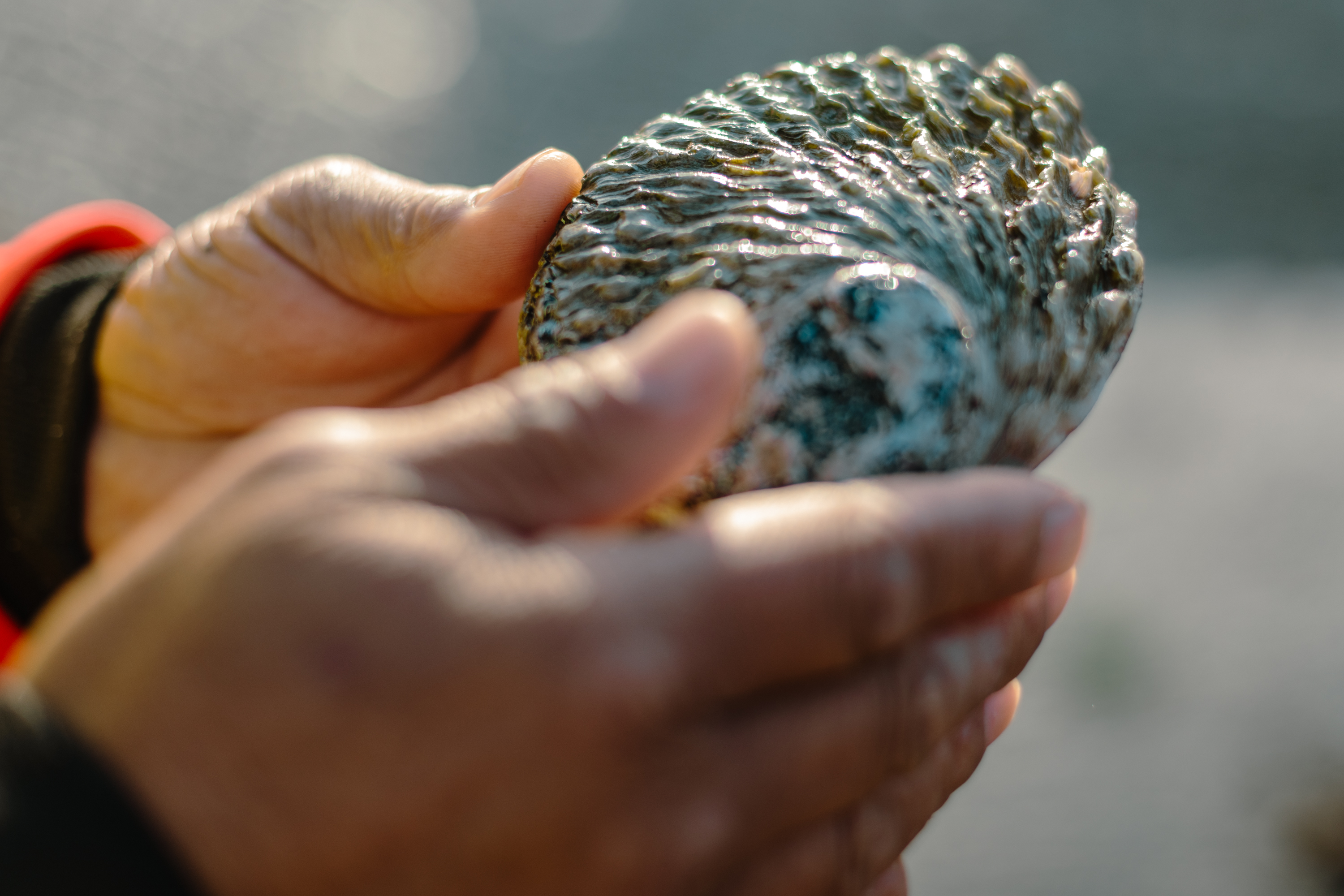
A view of the exterior of a washed up abalone in Hawston. Photo by Nicholas Muller.
A Well-organized, Opaque Route
According to the TRAFFIC report, “the abalone trade is dominated by illegally sourced products, with about one-third of it originating from South Africa and another third smuggled through neighboring countries to be exported. An estimated 65 percent of this trade occurs through the black market, making it the primary conduit for dried abalone to China, where a single glass jar can sell for 3,000 euros.”
Like an hourglass, “The trade chain starts with various fishers and processing companies, including poaching groups and illegal operations, narrowing significantly at the consumer end, where wholesalers and retailers distribute to restaurants, hotels, and households.”
According to a 2022 joint report by Kimon de Greef and Simone Haysom for the Global Initiative Against Transnational Organized Crime (GI-TOC), the most popular smuggling routes lead to the Namibian capital Windhoek, through Zimbabwe, for export to East Asia via Zambia, or even via the Democratic Republic of Congo (DRC).
“Abalone is leaving by multiple different points, small planes, and by car,” says Haysom, and the countries through which it is exported don’t always have coastlines. “At customs, they don’t have the legal basis to seize or investigate. It’s not a nationally protected species for them because it does not occur there,” she says.
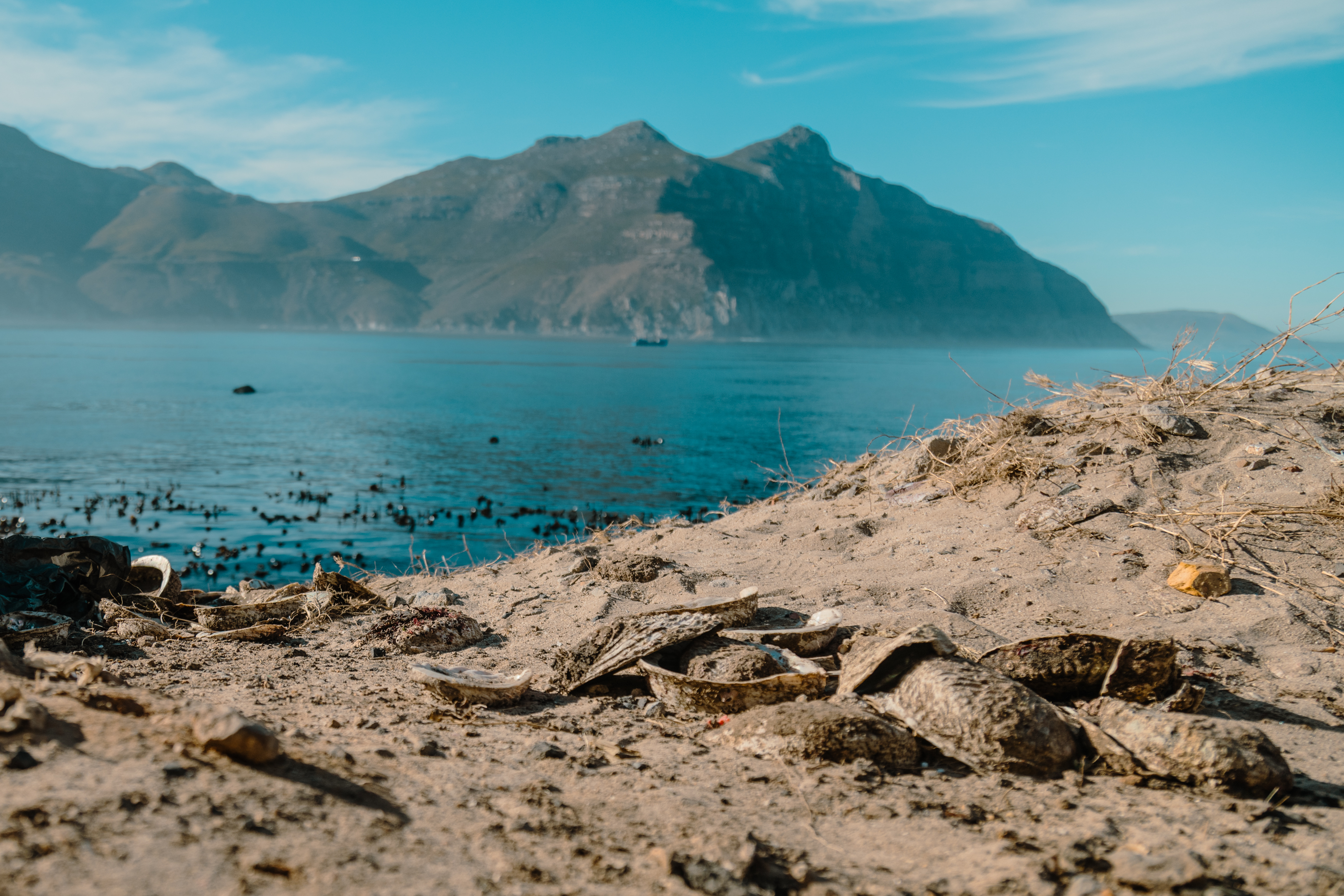
Discarded abalone shells seen in Hangberg. Photo by Nicholas Muller.
“In the beginning at the source, there is a huge level of harm, and extremely corrosive corruption that has hollowed out government institutions. This has been linked to illicit economies in South Africa along the coast where there are violent criminal gangs involved in certain stages of the supply chain who are using profits from abalone sales to buy guns,” she says.
“At the destination, you have an entire industry which looks the other way and accepts totally at face value that all the trade papers are in order even though when you speak to traders there is a high level of awareness that there is a huge percentage of the South African abalone supply coming from the black market. South African investigators can’t follow the money because they believe the money doesn’t even come into the country. There is a financial transaction that happens between criminal interests outside the country. The supply chain is extremely tightly controlled,” Haysom says.
“On the Hong Kong and Chinese side, it is quite a black box. South African investigators believe there is a small number of people who are involved, but it’s not clear what their relationships are to the broader underworld or upper world in [Hong Kong]. It’s extremely difficult to work with demand reduction when the country does not acknowledge that the products being sold are illegal. This makes the supply chains extremely invisible to consumers. This is why diplomatic engagement is crucial between South Africa and neighboring countries, and more importantly with Hong Kong and China,” Haysom ends.
Still Many Unknowns
De Greef details what he understands about the trade after years of research.
“Over the last three decades or so, a very well organized and smoothly run illicit industry has developed around abalone poaching, with often several layers of middlemen or intermediary buyers who buy poached abalone, aggregate it from multiple sources, and prepare it for export. This means drying abalone in illicit drying facilities, often located on farms, but sometimes in suburban homes, in some cases these homes have suddenly blown up when the gas bottles used to heat the abalone explode,” he says.
“There definitely is a strong organized crime element at the higher levels of this trade,” de Greef stresses.
“Over the years, multiple poaching syndicates including Chinese so-called bosses have been identified. Several have gone to court, [but] many others have not been prosecuted to date… Probably the largest was a man named Frank Barends who ran a large operation out of Gansbaai, and got out of jail after serving just a few years of his sentence,” he says.
“The importation of dried abalone along with other luxury seafood products like shark fin and sea cucumber has historically been controlled by a fairly small number of family businesses in Hong Kong, and precisely what connection they have to the poaching business in South Africa is difficult to establish,” he says. One of these figures is Yeung Koon-yat, a major figure in Cantonese cuisine, and known as the “abalone king.”
“There is a very direct line between what is happening in communities like Hawston and Hangberg and these businesses in Hong Kong that provide luxury seafood products for weddings, banquets, etc.,” de Greef ends.
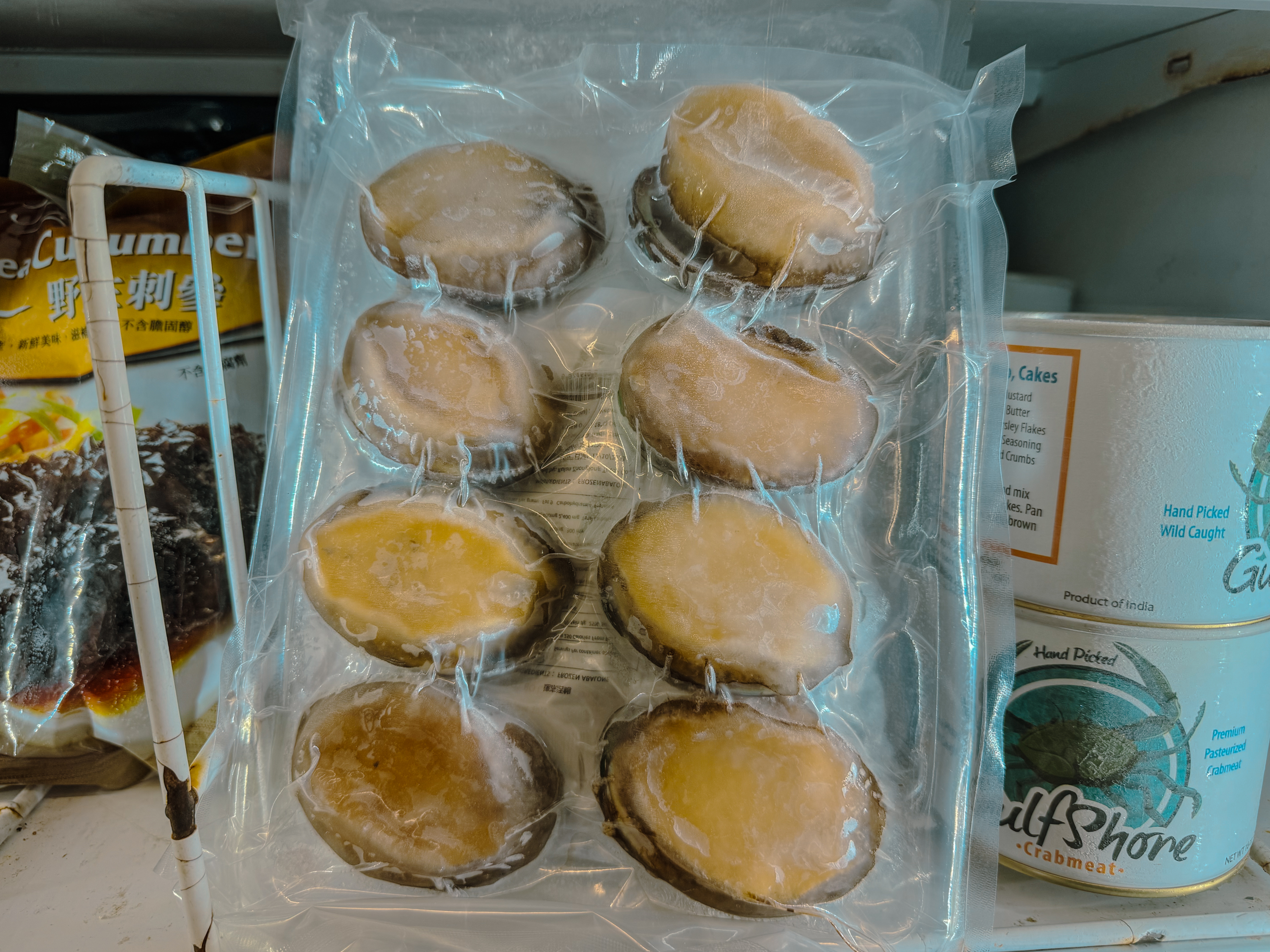
Frozen abalone seen in a locked freezer in a supermarket in Chinatown in New York City. Photo by Nicholas Muller.
Direct Effects on Local Communities Across the Cape
“There is a massive inequality between who benefits and who suffers. We have a very clear understanding of the harms in South Africa,” says Haysom. There are many options for enforcement, she says but they are “closed down because there is no international cooperation.”
“Hundreds of working-class men who have worked as poachers have been arrested without ever destabilizing the trade. The trade has become even more extractive, even more lucrative. There needs to be more local engagement with communities who have become more reliant on poaching,” says Haysom.
A prime example of one of these communities is Hangberg, originally built as a Khoisan village on the mountain. In the 1950s, as part of a separation policy under the Apartheid government, people classified as “colored” were forcibly moved from Hout Bay village to Hangberg.
Now, “People have started to build houses on the water’s edge. It’s the only place I know in the country where brown-skinned people have been able to take land back,” Shihaam says.
According to de Greef’s book, the abalone industry was dominated by White-owned commercial companies and most fishing communities of color were excluded from the profits of commercial abalone during Apartheid. This allowed for poaching to move in and became firmly rooted in these communities. Chinese buyers started coming into communities all along the coast like Hangberg, Hawston, and Kleinmond in the early 2000s, and the price subsequently skyrocketed.

The hand symbol used to communicate that there is abalone around. Photo by Nicholas Muller.
Tik, or meth, around the same time emerged in the townships and became easily available. Local bosses started trading abalone shipments for it, and inter-gang violence erupted as a result. Farmed abalone has also been targeted by gangs and syndicates.
It is not clear and is still disputed at what level drugs and cash are involved in the trade. What is known is that divers pay middlemen to deal with the abalone meat. Once shucked, the meat spoils quickly and must be quickly stored or dried. Talking to people in townships like Hangberg, most swore they did not know where the abalone ended up after leaving the area, but this could not be verified.
In the end, the poachers do not end up with much compared to people higher up in the illicit trade. Many who are caught are quickly released on bail. Police and others reportedly often tip off abalone poachers when raids are about to happen.
The Poaching Epicenter
Hangberg is the epicenter of abalone poaching in South Africa.
“People have built massive mansions on that strip… As the illicit trade evolves, residents of Hawston have houses there too now,” Shihaam says.
“When you drive in, you see piles of abalone… There are rubber duck boats [speedboats], scuba tanks, and hanging wetsuits in many houses. Young men sit on plastic chairs waiting to go into the water, or recovering after coming out of it,” she says.
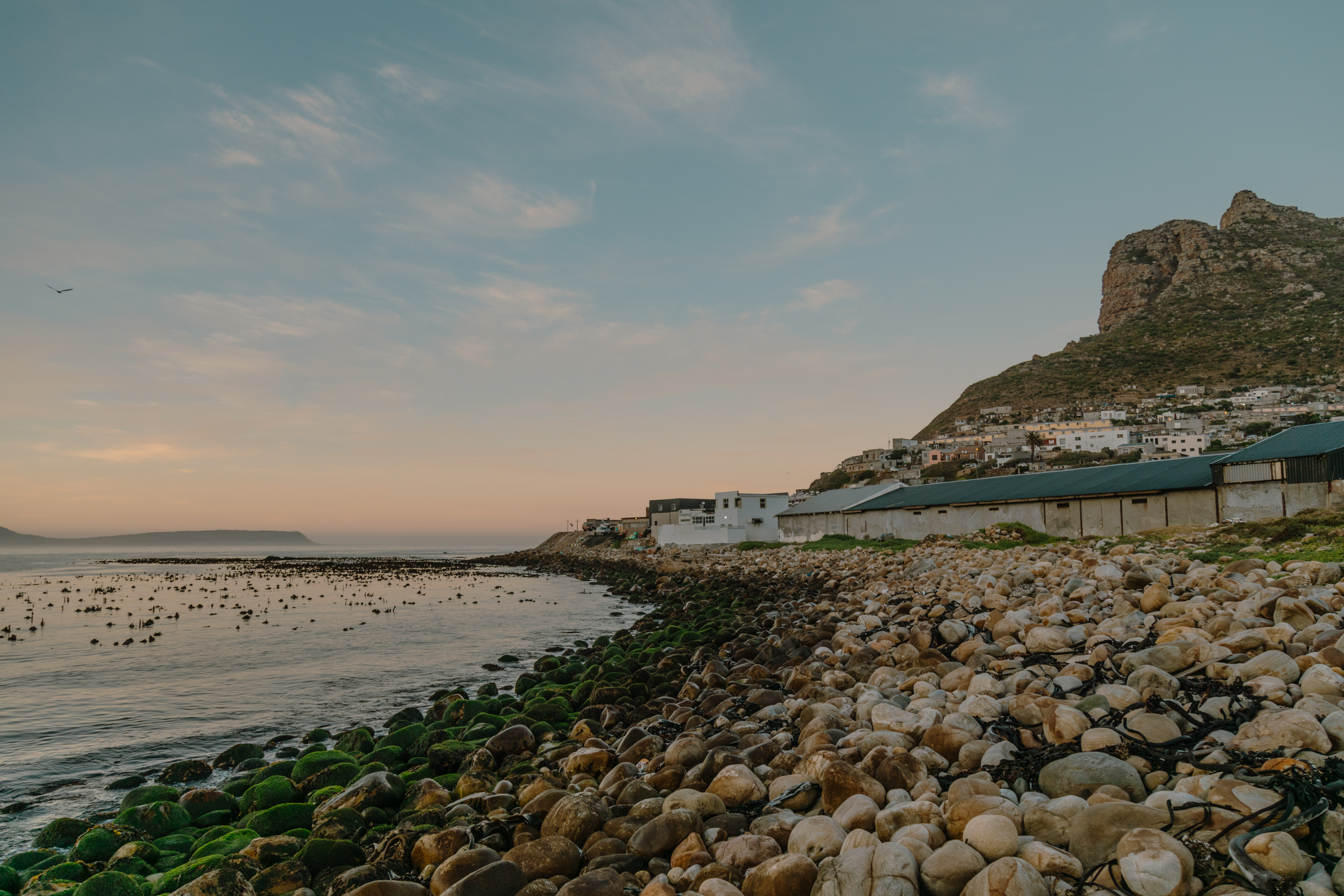
A view of the township of Hangberg, in Hout Bay. The tight-knit community is known as the epicenter of abalone poaching in South Africa. Photo by Nicholas Muller.
“If you come from a generation where your parents didn’t have dignity, or having dignity would make you a problematic human being, how do we reconnect our people back to that?” Shihaam says.
“This is where indigenous knowledge systems are so imperative,” she says, arguing that a lot of people have been corrupted. “Everyone in those communities goes through a stage of surviving on abalone but you [need to] do it respectfully. The connection is now lost, ” Shihaam ends.
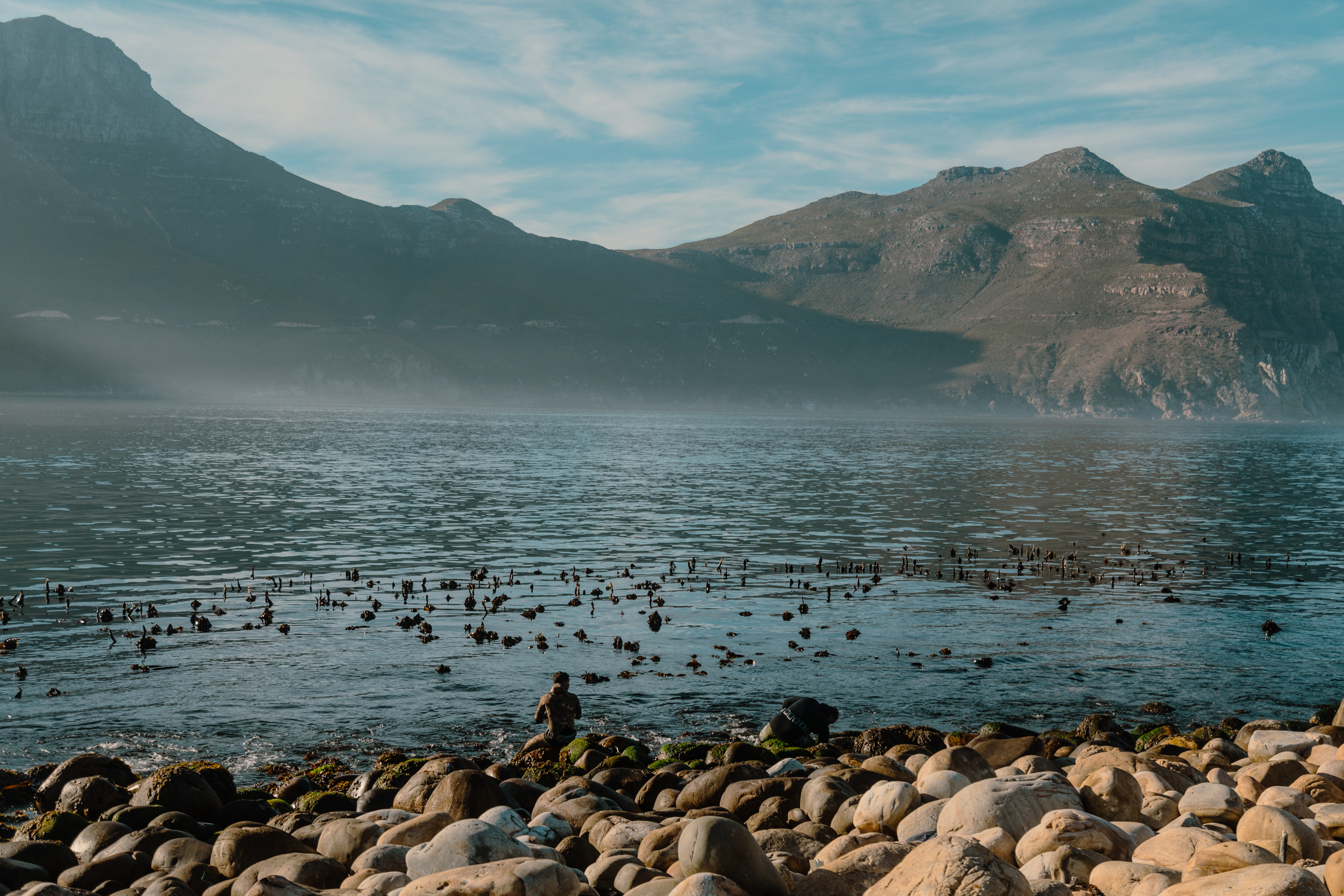
Two divers sit on rocks preparing to enter the water in Hangberg, in Hout Bay. Photo by Nicholas Muller.
Michelle
Michelle Singh’s family was displaced from Hout bay to Hangberg during Apartheid. After her father died at sea, she went to work at age 12 at the local fish factory (now abandoned) with her siblings for the rest of her childhood. “Fisher-people cannot stay far from the sea. This is where I want to die. The community stands together and belongs to us,” she says.
Singh, now 55, is against the destructive nature of poaching and is a community advocate for preserving the rich resources in Hout Bay.
“Everyone knows this is going on, and there are no police around,” she says.
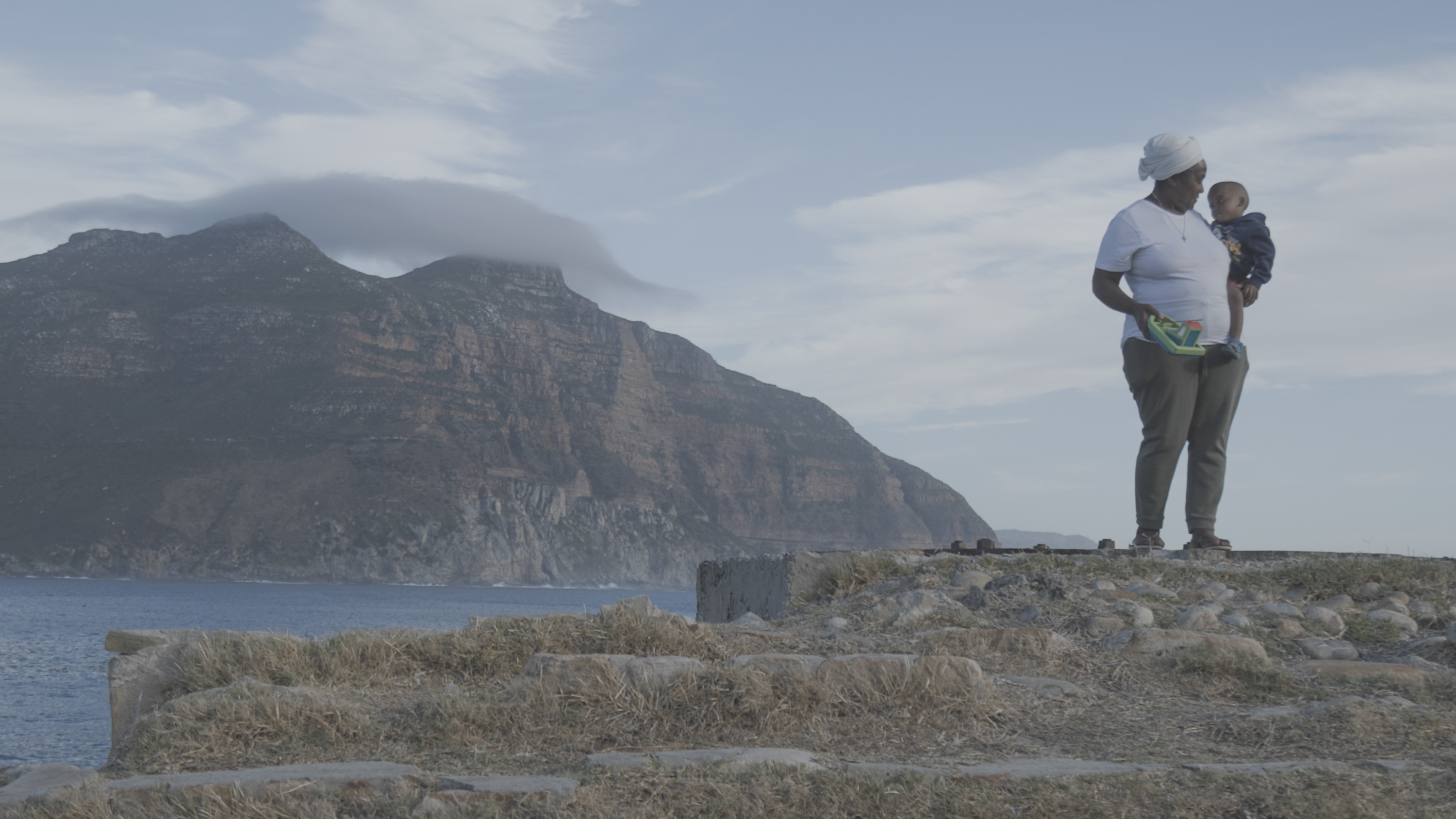
Michelle Singh, 55, is an active advocate for fishing rights for small-scale fishermen in her community in Hangberg, Hout Bay outside of Cape Town. Photo by Nicholas Muller.
“Chinese guys started to come into Hout Bay looking for divers who could go poaching for abalone. People weren’t clued up about how it would work. They thought they would get trained to dive, and then go to the government to tell them they are licensed divers, then people would start asking them to bring back a little more, and then it expanded and went underground with the mafia. It became more drug-related and more violent with gangsterism among certain people,” she says.
Singh complains that poaching has brought a host of other ills into the community.
“The youth don’t want to go to school because they think they can make quick money to buy expensive clothes, phones, cars, etc. There is no respect for the sea anymore from people,” she says.
“If [there wasn’t] someone in the government departments with their fingers in the pie, then this wouldn’t have happened. A local fisherman can’t afford a boat, tanks, and wetsuits. Who gives those to them? As soon as [the police] leave, the poachers go out in broad daylight and don’t care. These days, abalone is going to 1,200 rand ($65) a kilo, and poachers come out with 60-120 kilos, which is significant money,” she says.
“I cannot understand why the government can’t raid their houses,” Singh complains. “If the government can come to the fishing communities and put the responsibility in their hands, it would reduce the poaching here and stop the extinction.”
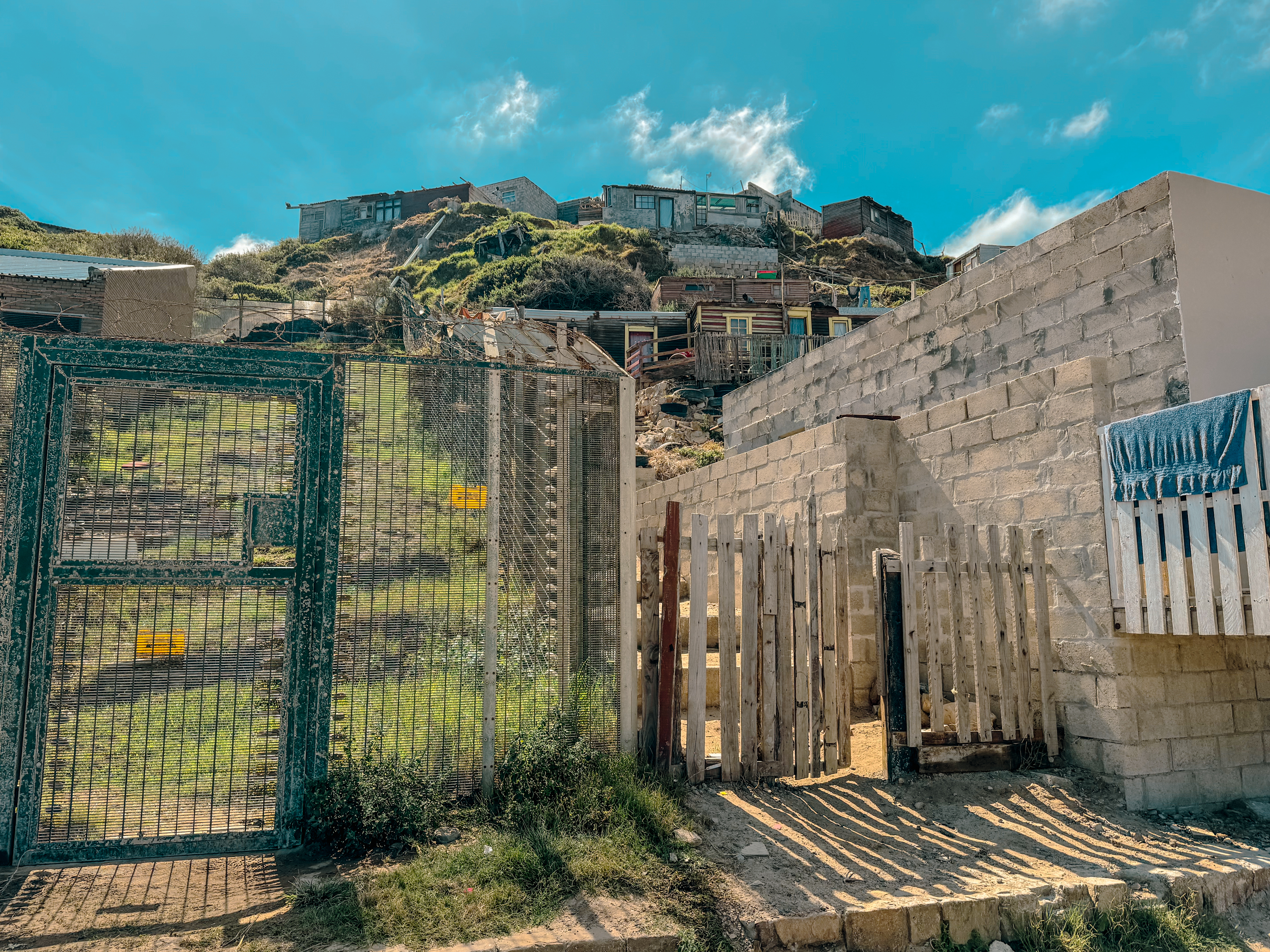
Informal settlements linked to abalone poaching continue to spring up in Hangberg. Photo by Nicholas Muller.
“At the moment, I am worried about what is going to happen to our community because of everything… because of the poaching, drugs, and killings to be on top. There is no more ubuntu, which is the one love that I grew up with,” she says.
Ubuntu in the South African context means to take care of each other as a family. It is making sure everyone has what is needed and not just taking care of yourself; it is an acknowledgment that you are who you are because of others. It used to be that when fishermen came from the ocean with a catch, they wouldn’t just take fish home; they would share it with others in the community.
“I would say to the consumer that they make sure that abalone or any other species on Earth was captured in the right way and wasn’t poached. Stop this black market business. One of these days, everything will become extinct. Think before you eat, check where it comes from, how it was caught, and how it was produced,” Singh ends.
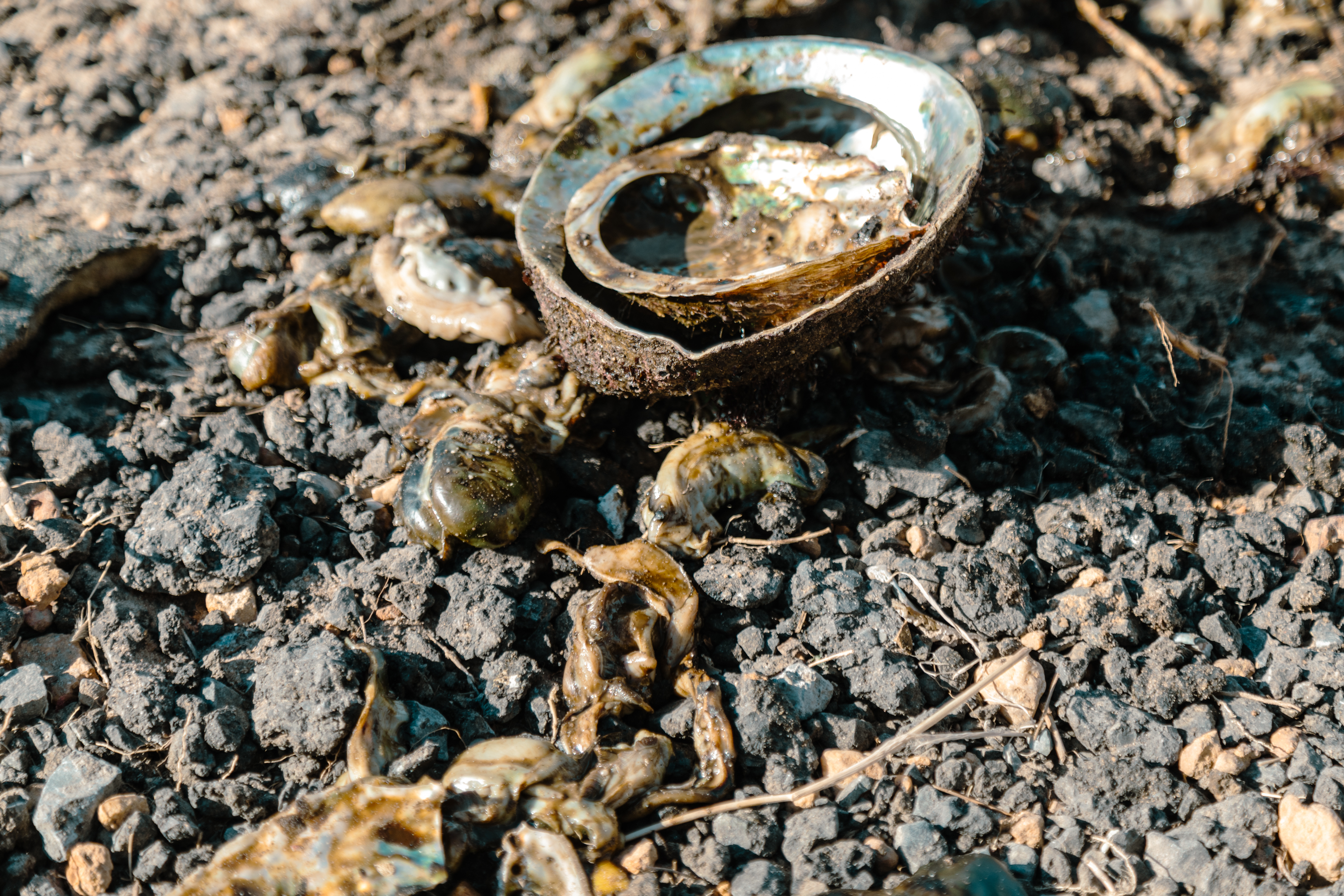
The remains of a recently shucked abalone in Hangberg. Photo by Nicholas Muller.
No Good Way Forward
Haysom says there are various policy avenues available. One of the more controversial suggestions is to give up policing poaching altogether, “which will result in a more rapid descent into commercial extinction of the species.” Commercial extinction would functionally mean the end of poaching, and the often violent policing of poaching.
“We’re not advocating that as a solution to the trafficking routes, but as a harm mitigation measure because when looking at the environmental harms… commercial extinction is probably going to happen anyway if things continue the way that they do,” she says.
“On the global scale, it is one of the clearest examples of how corruption linked to environmental commodities can be so corrosive for local governance institutions. These criminal networks can move around from country to country with impunity engaging in corruption, which is destabilizing for countries extracting resources to the point of collapse.”
“We are going to be faced with a lot of difficult tradeoffs as crises accelerate and amplify each other, and I think we would have better conversations if we understand what to save and what not to save,” Haysom says.
“The direct environmental impact is the collapse of a species, which has profound economic impacts, ” says de Greef.
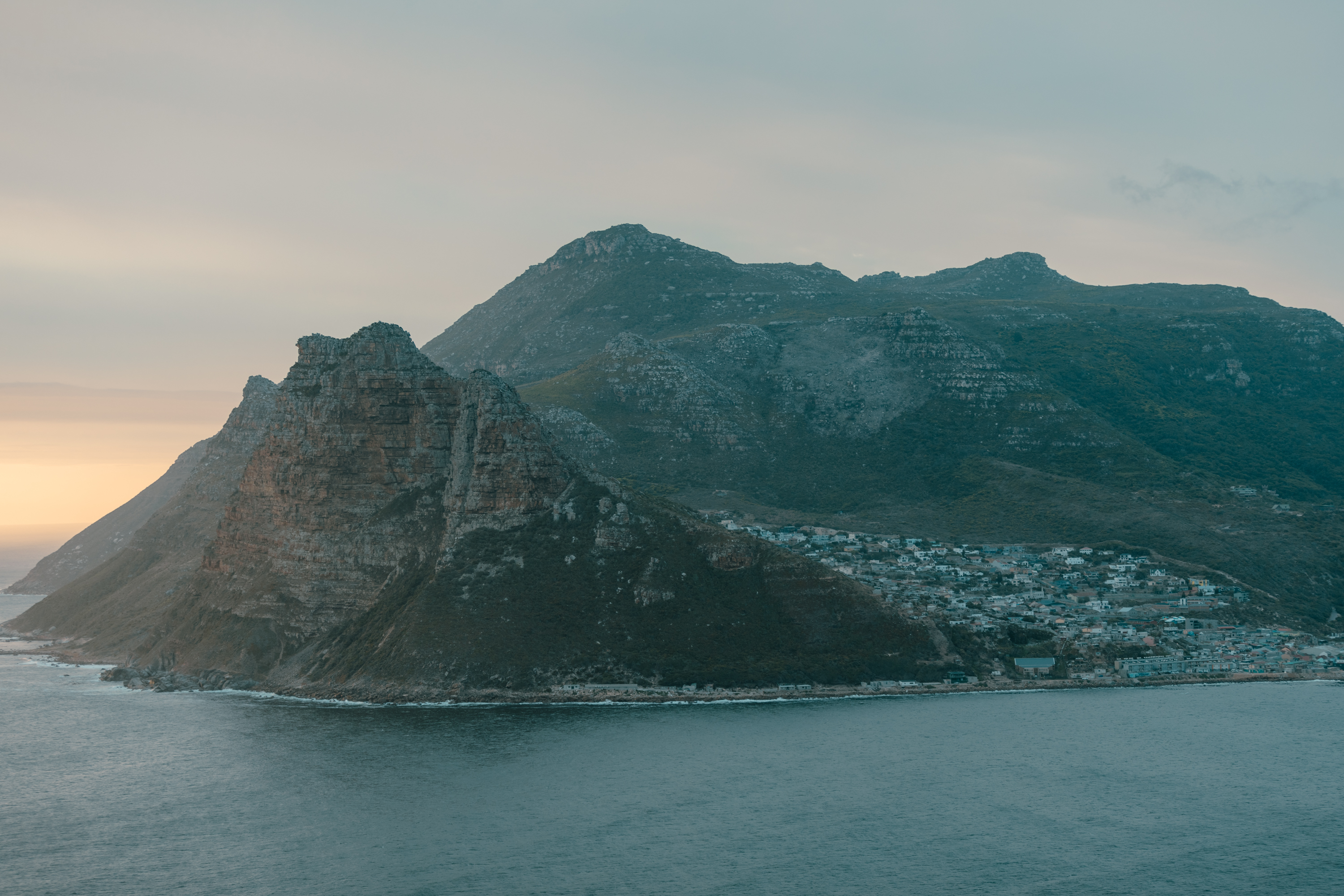
A view of the community of Hangberg seen across Hout Bay from Chapman’s Peak. Photo by Nicholas Muller.
He says “abalone could’ve been used as a tool for local economic development in fishing communities in a legal way that equitably paid out,” but “now it’s too late to do that…”
Instead, violent gang control the trade. “Poaching is feeding into the system where very big gangsters are becoming even bigger through the money generated by poaching,” says de Greef.
Just as abalone is important in East Asia, he says, “There is also cultural loss” in South Africa as abalone populations shrink. “Abalone is culturally important for many South African people. It’s something they grew up eating and abalone has been consumed since the time of the first peoples, from the Khoi and the San you will find abalone shells.”
For those in these local communities hoping to combat illicit abalone poaching like Papi, Michelle, and Russie, either way, they will continue to pay a heavy price.
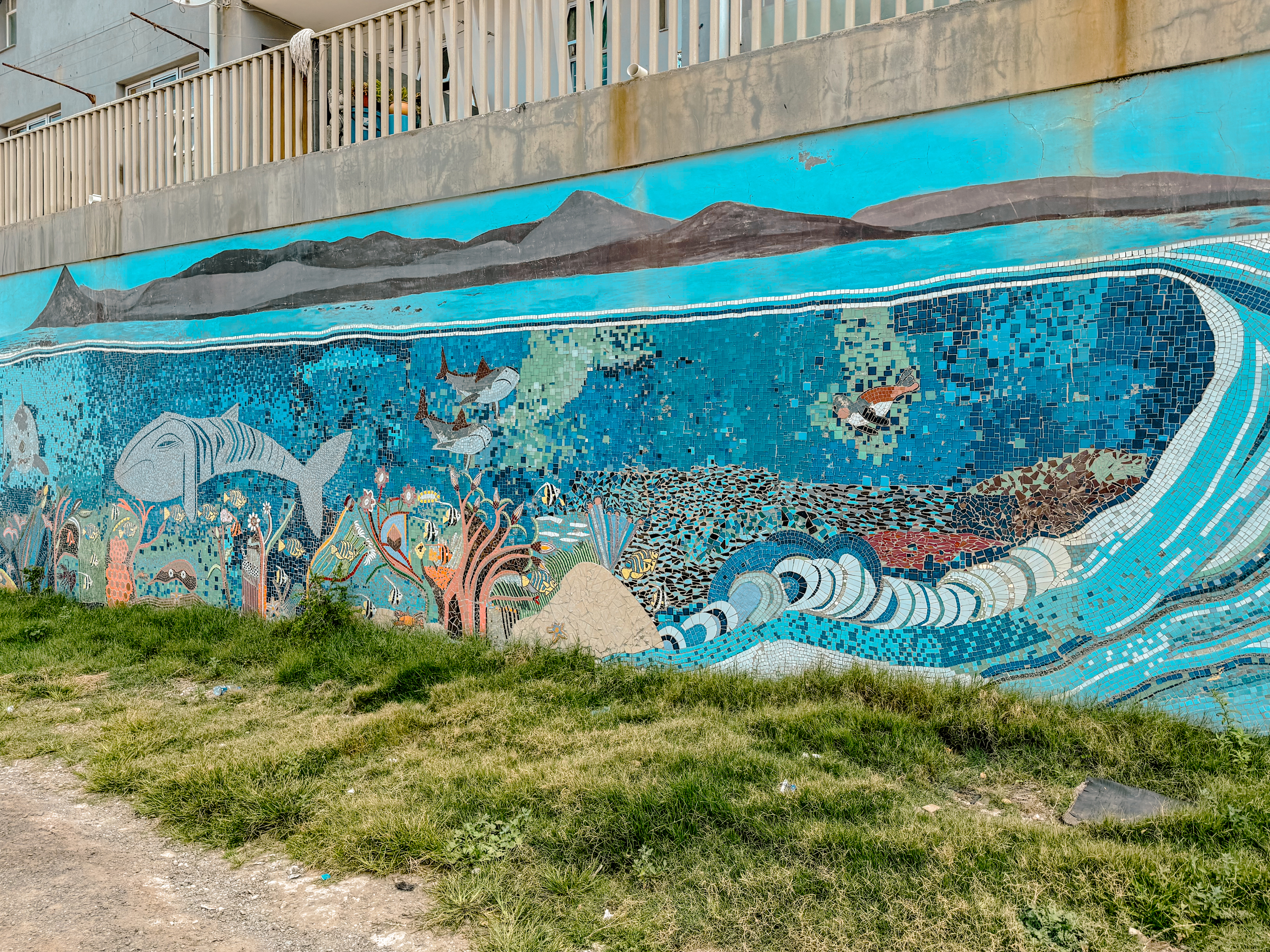
A sea themed mural seen in front of public housing in Hangberg. Photo by Nicholas Muller.

































